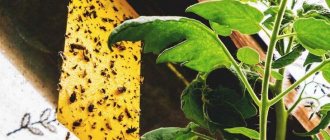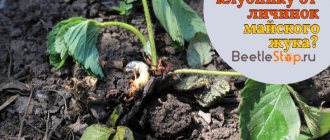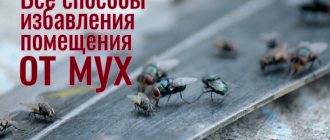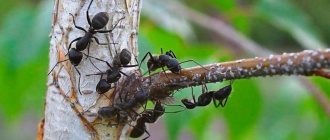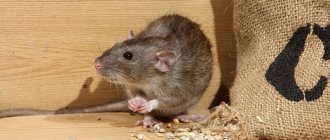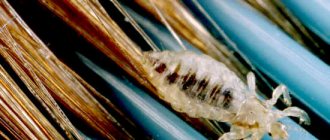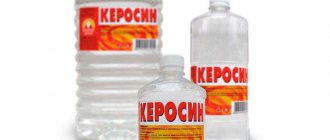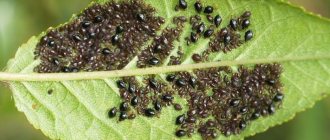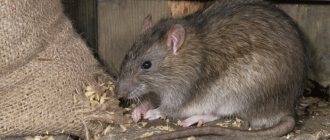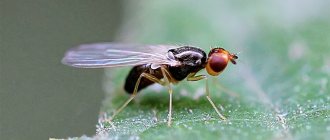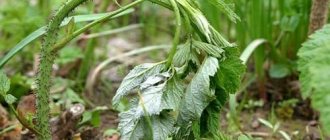Nematode
The species community of nematodes - small roundworms - is diverse. Scientists have described more than 24,000 species, but tens of times more have not been studied. These microscopic worms can be both beneficial - they live in soil, water and are an important part of the ecosystem, and harm - they parasitize plants, animals and humans.
Description of the pest
Herbivorous nematodes have a small thread-like and rounded body up to 2 mm long , narrowed at both ends. Due to the small size of the pest, it is difficult to notice in the early stages.
The color of nematodes can be white or light yellow. The body is covered with a ringed cuticle, under which there are longitudinal muscles. Special muscles ensure the functioning of the reproductive and digestive organs.
The pest has a developed nervous, digestive, excretory system, and reproductive organs, but lacks blood supply and respiration. The digestive system is continuous - it begins with the oral cavity, which has a complex structure, passes into the esophagus, then into the midgut and ends at the posterior end of the body.
All herbivorous nematodes have a movable spine in their mouth - a piercing stylet organ. Worms use it to pierce plant cells and suck out the juices. Enzymes, amino acids, urea and other substances are released into the tissue through the thorn. They block the functioning of all organs in the plant.
The nervous system consists of a nerve ring located near the pharynx and longitudinal nerves. Thanks to the setae on the body, worms can touch; amphid receptors are responsible for the sense of smell.
Herbivorous nematodes are heterosexual , females are larger in size than males. They lay eggs from which larvae emerge. Before adulthood, there are 4 stages of development, accompanied by molting. Depending on the species and living conditions, the duration of each larval stage lasts 2–12 days.
The optimal temperature for the appearance of larvae is 15-16°C, for further development 18–24°C. 40 days after the onset of sexual maturity, females can lay eggs.
General information:
Nematodes on indoor plants most often appear due to the use of garden soil for green pets. As for various garden crops and flowers, this parasite is found there much more often than at home.
Nematodes in appearance are roundworms, but very small in size. Therefore, it is quite difficult to notice them, as well as to completely remove them. But additional information will help to detect nematodes in time and deal with them correctly.
Nematodes are plant parasites belonging to a type of worm. You can find different classifications: some books classify the parasite as a roundworm, while others classify it as a gastrociliary class. About 80 thousand species of nematodes are described in the literature, but many experts believe that the real number of species is about a million, because new nematodes are constantly being found and described.
Nematode worms live not only in the ground or on indoor and garden plants. This type of parasite can be found in animals and even in humans. Nematodes live not only in the soil, but in fresh water bodies and even in the seas.
The size of the nematode, in terms of length, can vary greatly. Some representatives reach only 80 microns in length, while others can reach up to eight meters. The long fusiform body tapers at the ends. In cross section, the body is round and symmetrical.
As for the color of nematodes, it can vary greatly depending on the species. Reproduction methods are carried out by laying eggs in the soil, on a plant or in another environment where a particular parasite lives.
Types of nematodes
Different types of nematodes specialize in damaging roots, stems, leaves, buds and flowers. Based on this, a species classification of plant-parasitic nematodes .
Leaf nematodes
Motile colorless worms up to 1 mm long. Distributed everywhere. But in open ground they are more harmful in wet years in the central zone, in the northwestern region and in the south of Russia. They parasitize on the above-ground parts of plants: outside or inside leaves, buds or buds. The soil is a temporary habitat for them. They move along a thin film of water on the surface of the plant and penetrate inside through small lesions and stomata.
One generation develops within 10–11 days; 20 or more generations can appear in a year. The pest overwinters only in above-ground parts, most often in young shoots. It reproduces in leaf axils, buds and in mesophyll microorganisms on the surface of plants.
Leaf nematodes attack strawberries and ornamental plants: chrysanthemums, asters, begonias, dahlias, phlox, primrose, iris, gerberas, pelargonium, peonies, violets, lilies, cyclamen and others.
Stem nematodes
Transparent thread-like worms up to 1.7 mm in length. In our country, this species is found everywhere on heavy soils and is active in regions with a temperate climate. The life cycle of one generation lasts 3–5 weeks, the favorable temperature for the development of the pest is 5–34°C. During one season, 4–6 generations appear. The females of this nematode are fertile, laying from 200 to 400 eggs. The pest overwinters in rhizomes, roots and stem bases.
Stem nematodes live on 500 species of vegetable, berry and flower and ornamental crops. The above-ground parts are damaged: stems, leaves, flowers, as well as seeds, rhizomes and bulbs. It hardly damages the roots. They penetrate only into living tissues through stomata, where they live and reproduce.
Stem nematodes prefer to parasitize one host plant without moving to other species. from stem nematodes : onions, potatoes, tomatoes, peppers, eggplants, carrots, pumpkins (cucumber, watermelon, pumpkin), ornamental plants: tulips, phlox, begonias, hyacinths, carnations .
Root nematodes
Colorless round worms, 1.3–1.5 mm long, living in the soil near the roots of plants. This type of nematode is divided into 3 groups:
Root-knot nematodes
The saliva secreted by the pest causes the formation of round or elongated thickenings on the roots - galls 3-5 mm in size . Inside the galls, nematodes feed on plant sap and reproduce annually from 1 to 13 times. Females lay up to 2000 eggs in special egg sacs over the course of 2–3 months. Males do not always take part in reproduction. The emerging larvae migrate, find the roots of the new host plant and begin to feed. They reach sexual maturity in 3–4 weeks.
Dangerous for more than 400 plant species - vegetables and ornamental crops. They are sensitive to low temperatures and are more often found indoors. Celery, lettuce, carrots, tomatoes, eggplant, peppers, strawberries, melons and legumes are severely . Ornamental plants include roses, clematis, ficus, begonias .
Free-living nematodes
Common on coarse-porous and sandy soils. Thanks to good aeration, the pest actively moves in the ground. Lettuce, celery and carrots are often affected by this pest.
Nematodes with free cyst formation
The spread of the pest occurs with the help of cysts formed on the roots - dark brown capsules the size of a poppy seed . Dead females with viable eggs and larvae turn into cysts. Each cyst contains up to 700 eggs and larvae.
The larvae do not die in winter and leave their shelter with the arrival of warm weather, but can remain in this preserved state for up to 10 years. Representatives of this group include golden potato nematode on nightshade crops, beet nematode , which damages cruciferous plants and beets.
Pests deplete plants and contribute to the spread of fungal, viral and bacterial diseases, the pathogens of which penetrate through damaged roots. With severe infection of roots, losses among vegetable crops reach 25–80% after 3–4 months.
General information
The nematode was imported from South America, and is now found everywhere in the Russian Federation and nearby countries.
The lifespan of nematodes and their appearance vary and depend on the species, but they accumulate in the soil over several years. When the bush is damaged, the tubers begin to rot and the products become unsuitable for storage. In addition, the nematode carries viruses, causing diseases.
Signs of plant infection by nematode
For successful reproduction and development of nematodes, heat and humidity are required. Rainy summer weather, acidic and sandy soils contribute to the spread of pests . In dry soil and when the temperature drops, they fall into suspended animation, stop reproducing or die.
Nematode on strawberry
Yellow-brown, reddish spots appear between the veins on strawberry leaves. The petioles also change color: they turn red and lose their pubescence. In places of darkening, the leaves become thinner, turn brown, dry out or rot.
Infected bushes lag behind in growth and development. The whiskers are shortened, the rosettes are deformed, and their central part dies over time.
Nematode on potatoes
Worms penetrate the roots, suck the juices out of the plant, taking away the strength for growth and development. Such bushes have only 1–3 stems, the leaves are small - during the day they look lethargic, lose their green color and turn yellow, and then dry out. The root system weakens, tubers do not set at all, or there are few of them and most of them are small.
Nematode on onion
Plants into which nematodes have invaded develop thickened and curved feathers, which turn yellow and droop over time. Inside, the bulb becomes soft and loose, and begins to rot from the inside.
Nematode on beets
On affected plants, the leaves change color - they turn brown and become limp. The beets are stunted in growth, and signs of rot are visible on the root crops removed from the ground. If they are not damaged, then most often they are small in size and have many adventitious roots. In winter, such a crop is poorly stored.
Nematode on chrysanthemums
Nematodes damage many ornamental plants, but most often among garden flowers they settle on chrysanthemums. First, light yellow spots appear on the leaves. They turn brown and the leaves die. The shoots are shortened, and some appear thickened and swollen.
Flowers on such chrysanthemums do not form or become smaller and deformed. The chrysanthemum nematode also damages other garden flowers: asters, delphiniums, zinnias, phlox, begonias .
Common mistakes
Often gardeners, especially beginners in the field, make mistakes, due to which all efforts aimed at combating the nematode are reduced to zero. One of them is the use of insecticides. Such products demonstrate excellent results in the fight against insects; they are powerless against worms.
It is also worth noting the placement of affected bushes in a compost pit. Pest eggs are resilient, so they can easily survive the winter, and in favorable conditions they can live up to 10 years.
Affected crops are not treated in a timely manner. if there are few affected bushes, then it is better to remove them so as not to infect the entire plantation.
Fighting nematodes is not easy. But it is still possible to defeat this parasite if you notice signs of strawberry damage in a timely manner and take appropriate measures.
All your articles will be on this page.
Nematode control agents
Chemical and biological drugs
Heterophos
The soil insecticide is produced in 2 forms: granules and suspension. Consumption of the drug in dry form is 4-8 g per 1 square meter. m. To soak the roots of seedlings before planting, prepare a solution of 15 g of the drug and 10 liters of water. The toxic effect on the pest lasts 1.5–2 months.
Phosfamide
Insecticide of contact and systemic action. To spray plants and soil against nematodes, use a 0.02% insecticide solution. Work is carried out in dry and windless weather.
Nematorin
Granular insecticide against all types of nematodes. Affects the pest's breathing, causing paralysis and death within a few hours after application. The drug is applied before and after planting plants into the soil to a depth of 10–15 cm. The consumption rate of the product is 3 g per 1 sq. m. m.
Akarin P
An effective remedy in powder form for root-knot nematodes. The decomposition products of the drug deprive the pest of the ability to find the roots of the host plant and the nematodes die within 14–20 days. The drug retains its properties for 2–4 months, is not washed out of the soil by water and increases resistance to disease.
Akarin is applied into the ground to a depth of 20–25 cm 1–3 days before planting or spot-on when replacing an infected plant with a new one. When applied in rows, the consumption of the drug is 200 g per 1 sq. m.
Nematophagin
Liquid biological product against nematodes based on a predatory fungus. Ring-shaped trapping nets develop on the mushroom mycelium. By touching them, the pest sticks and gets caught in the net. Within 24 hours, the fungus consumes the nematode. Developing in the soil or on plant debris, predatory fungi release metabolic products that are toxic to worms.
The drug is applied to the soil before sowing (100–300 ml per 10 liters of water), planting plants in the ground (5–10 ml in each hole or 1–3 liters per 1 sq.m.), the soil around the affected plants is treated (20–30 ml per 1 plant to a depth of 15–20 cm).
Fitoverm P
To disinfect the soil, 1–3 days before planting, the powder is evenly scattered over the surface of the ground and mixed to a depth of 10–15 cm or 18 g in each hole if it is necessary to replace a diseased plant. The protective effect lasts up to 2 months.
Traditional methods
Herbal decoctions and infusions cannot cope with the nematode . Non-chemical methods will repel the pest by planting phytoncidal plants in the rows: calendula, marigolds, mustard lettuce .
Root nematodes are caught using baits . The juice is squeezed out of potato sprouts and introduced into the soil. Since the pest has a good sense of smell, the smell serves as a signal for the cyst to open, but not finding food, the larvae die. This procedure is carried out 1–1.5 weeks before planting.
The number of nematodes in the surface layer can be reduced by thermal soil treatment . Before planting, water the soil with boiling water, saturating it to a depth of at least 15 cm. This method is more suitable for greenhouses and greenhouses.
Symptoms of damage
The main danger of the strawberry nematode is that, due to its microscopic size, it is almost impossible to see it at first. Consequently, even the most attentive gardener will most likely miss the moment when worms settle on his territory. And he will do this not because of his own carelessness, but because the nematode is practically invisible.
Gradually, the soil will become more and more contaminated, which will lead to a decrease in the quality of the strawberry crop. At some point, strawberries will stop bearing fruit altogether. And you may never understand what's going on
If you have even the slightest suspicion of strawberry nematode, pay attention to the symptoms of infection. Below are the methods by which the infection can be recognized at the beginning of the journey:
Dig up one strawberry bush and carefully examine its root system. Do you notice anything strange or unusual? If not, great. So, they sounded the alarm in vain. However, in the vast majority of cases, the summer resident sees something like the following:
- roots are poorly developed;
- there are a large number of cysts (bubbles) on the roots;
- Visually, the cysts are similar to poppy seeds, but not black, but white.
If the moment of primary infection was missed, total infection can be recognized by the following symptoms:
- the veins on the strawberry leaves became noticeably thicker and rougher;
- the leaves have turned yellow instead of retaining their bright green color;
- the foliage began to curl, wrinkle, and metamorphoses uncharacteristic of strawberry bushes began to occur;
- the bushes practically stopped growing;
- The strawberries took on a strange, bizarre shape that was not typical for them before.
Prevention
Effective preventive measures against the pest are:
- Maintaining crop rotation.
- Growing varieties and hybrids resistant to nematode damage.
- Selection of healthy planting material.
- Before planting, bulbs and tubers are heated for 15 minutes at a temperature of about 45–50°C.
- Reducing soil acidity (regular liming) reduces the number of pests.
- Plantings are regularly weeded and thinned.
- Post-harvest plant residues are removed from the beds and the remaining damaged plants are destroyed along with the soil layer.
- Sowing cereals in late summer - early autumn cleanses the soil well and increases fertility. The area cleared of weeds is loosened and sown with grain crops to a depth of 2–3 cm. Before frost they will germinate and the soil along with the green sprouts will be dug up and the entire layer of soil will be turned over.
Today, when a pest appears, there is no need to abandon the site and wait for years for the soil to be cleared of the nematode. Modern drugs successfully fight them, and preventive measures will prolong the effect for a long time.
Find out more about the nematode and how to fight it from the video.
Preventive recommendations
Even if nematodes are not found on the site, this does not mean that they cannot appear on it at any time. In any case, you should follow the rules that will help avoid the appearance of such parasites. That's why:
- First of all, it is necessary to follow the rules of crop rotation and not plant garden crops in the same places. It is better if resistant potato varieties are cultivated on the site.
- As a preventive measure, it is better to dig up the soil on the site in the fall.
- Do not plant seeds of infected plants or feed them to domestic animals.
- It is not recommended to move soil from contaminated areas.
- If seeds are purchased, then only at trusted retail outlets.
If you follow the rules, and they are basic, you can protect your garden plot from many pests, including nematodes
At the same time, we should not forget about regularly examining your plants, paying attention to their healthy appearance.
Medvedka
Mole cricket and her nest
A large (up to 5 cm) brown-brown insect is one of the most dangerous enemies of modern gardeners. The mole cricket is omnivorous, reproduces quickly, laying one and a half to two hundred eggs at a time, and quickly gets used to pest control drugs, becoming practically invulnerable.
Why is mole cricket dangerous?
“Earth crayfish,” as the mole cricket is often called for the shape of its front legs and body structure, is dangerous for absolutely all plants in the garden. This pest eats root vegetables, potatoes, roots and bulbs of flowers, shrubs and trees. Both adults and larvae are able to dig their burrows near plant seedlings and drag them underground to eat.
An insect can enter a site either on its own or with imported fertilizer or soil. The appearance of a mole cricket can be detected by the sudden wilting of seedlings and the surface of the soil, riddled with holes.
Preventative measures against the appearance of mole crickets
It is impossible to completely protect an area from the appearance of mole crickets, but you can quickly detect the first pests if you take preventive measures seriously:
- dig up and sift purchased soil, manure and compost before adding to the beds;
- weed or mow the weeds in the area, remove litter and mown grass, without leaving overgrown corners;
- If you find a nest or egg-laying during the seasonal digging of the soil, pour boiling water over it.
How to get rid of a mole cricket
Oviposition of these insects occurs in May, so in order to reduce the population on your site, it is advisable to combat mole crickets before this time. They are not easy to find in the ground, but there are many effective ways to make life difficult for pests.
- When you find mole cricket passages, you need to pour a soap solution into them (200 g per bucket of water). Up to 8 liters of water are consumed per 1 square meter to wet the ground to a depth of 10 cm.
- During the mole cricket flight period (in May), buckets with a water-kerosene emulsion are installed on the site, above which there is a light source. The mole cricket flies into the light, hits the lantern, falls into a bucket of oily liquid and dies.
- In early May, small (up to 25 cm in height) piles of manure are laid out around the site. The females choose them for laying, and after 3 weeks the summer resident must stir up the pile and get rid of all the insects inside before they spread throughout the area.
- At the beginning of autumn, liter jars of manure are dug into the area below ground level. Mole crickets, attracted by the warmth, go there for the winter, and with the onset of cold weather they are dug up and destroyed.
- A champagne bottle is dug in at an angle and partially filled with a solution of honey or beer. The mole crickets that crawl in on the smell will not be able to get out and will die.
- In large areas where the number of mole crickets is large, trapping pits can be arranged. To do this, dig a hole (50x50 cm) and fill it with manure, cover it with earth on top. In winter, the soil is removed, the manure is scattered, and the mole cricket is destroyed.
- Before planting seedlings in the ground, granules of poisonous bait preparations can be added to the ridges. The most common are Thunder, Grizzly, Medvetox, Phenaxin Plus, Zarit. They do not oppress plants, do not accumulate and gradually decompose in the soil. Despite the fact that these are drugs of the third class of danger, they cannot be left on the surface of the earth without sealing and you must carefully read the instructions before use.
Reasons for appearance
The best conditions for the life activity of the parasites in question are moderate humidity, air temperature in the range of 20-30 ͦC, soil acidity level 5.5-5.8. However, worms do not appear on plants only due to favorable conditions. The main reason is always infection.
So, you can transfer parasites to your garden on shoes or the wheels of a vehicle. The larvae can be carried by the wind from neighboring areas, with diseased seeds. Their spread is also facilitated by infected seedlings and work equipment.
Morphology
Imago. Along with common morphological characteristics for all nematodes, meloidoginids have a number of characteristics that distinguish representatives of this family.
Root-knot nematodes are identified by first using differences in cuticle patterns between the vulva and anus (perineum, or perineal area) in mature females. (photo)
When examining the posterior end of the body of females, a horizontally located opening of the vulva and above it a small round anus, surrounded by numerous cuticular grooves, are visible.
These grooves are wavy and arranged in arcs around the anus and vulva. The cuticular grooves on the sides are interrupted by lateral lines or replaced by short stripes.
Phasmids (organs located on the sides of the tail) are often visible as small dots that refract light strongly.
The female, like all representatives of the order Tylenchida, is swollen, elongated oval, lemon-shaped or spherical in shape, with the head end immersed in the root tissue.
The male may be absent in populations of some species. Like all Tylenchida, it has a typical worm-like shape and, as a rule, does not feed. The stylet is developed, the esophagus is differentiated.
The egg, like that of all plant nematodes, is elongated oval or kidney-shaped. The eggs are relatively large in size. They are often almost equal to the diameter of the female's body. The eggs are covered with a complex multilayer membrane and contain a small amount of yolk in the cytoplasm.
Larva. The formed larva is similar to an adult nematode, differing from it in its underdeveloped reproductive system. The larva has a powerful exoskeleton in the form of a cuticle.

